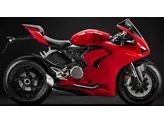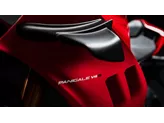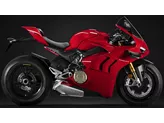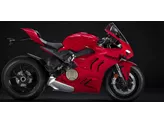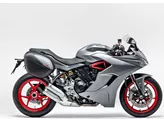Ducati Panigale V4 S 2018 vs. Yamaha R1 2016

Ducati Panigale V4 S 2018

Yamaha R1 2016
Visão geral - Ducati Panigale V4 S 2018 vs Yamaha R1 2016
The Ducati Panigale V4 S 2018 and the Yamaha R1 2016 are both high-performance supersport motorcycles with impressive specifications and features.
Starting with the Ducati Panigale V4 S 2018, it boasts a powerful 1103cc engine with a bore of 81mm and a stroke of 53.5mm, resulting in a high power output of 214 HP and a torque of 124 Nm. The engine has a compression ratio of 14 and features 4 cylinders with 4 valves per cylinder, utilizing the Desmodromic valve system. The bike's suspension is equipped with a telescopic upside-down fork at the front, providing excellent handling. The chassis is made of aluminum and features a monocoque frame, ensuring a lightweight and rigid structure. The front brakes consist of dual discs, and the bike is equipped with advanced rider assistance systems such as ABS. The dimensions include a front tire width of 120mm, a front tire diameter of 17 inches, a rear tire width of 200mm, a rear tire diameter of 17 inches, a wheelbase of 1469mm, a seat height of 830mm, and a curb weight of 195kg with ABS. The fuel tank has a capacity of 16 liters.
On the other hand, the Yamaha R1 2016 also offers a powerful engine, with a displacement of 998cc, a bore of 79mm, and a stroke of 50.9mm. The engine produces a slightly lower power output of 200 HP and a torque of 112.4 Nm. It has a compression ratio of 13 and features 4 cylinders with 4 valves per cylinder, utilizing the DOHC valve system. The suspension setup includes a telescopic upside-down fork at the front, providing dynamic handling. The chassis is made of aluminum and features a Deltabox frame, ensuring a lightweight and rigid structure. The front brakes consist of dual discs, and the bike is equipped with advanced rider assistance systems such as launch control and traction control. The dimensions include a front tire width of 120mm, a front tire diameter of 17 inches, a rear tire width of 190mm, a rear tire diameter of 17 inches, a wheelbase of 1405mm, a seat height of 855mm, and a curb weight of 199kg with ABS. The fuel tank has a capacity of 17 liters.

Ducati Panigale V4 S 2018
In terms of strengths, the Ducati Panigale V4 S 2018 is often regarded as a dream bike with an excellent image. It offers impressive brakes, a comfortable seating position even for taller riders, and a huge lean angle potential. The bike features a leading electronic package and a powerful engine that is finely controllable. Both experienced riders and amateurs can make good use of the machine's potential within their capabilities. The handling is clever, with the bike always finishing the corner early and ready for acceleration.
On the other hand, the Yamaha R1 2016 is praised for its dynamic handling, high-revving engine, and precise control. It also features an excellent electronic package, including launch control and traction control.

Yamaha R1 2016
However, the Ducati Panigale V4 S 2018 has a few weaknesses. The seat tends to heat up noticeably, which can be uncomfortable during summer rides. The seat-tank combination provides little grip in the braking zone, and stability at the limit requires careful tuning and discipline with the seating position in fast and bumpy sections.
Similarly, the Yamaha R1 2016 has a minor weakness, as its quick shifter is only available for upshifts.
In conclusion, both the Ducati Panigale V4 S 2018 and the Yamaha R1 2016 are powerful and capable supersport motorcycles. The Ducati offers a higher power output and a more advanced electronic package, while the Yamaha excels in dynamic handling and precise control. Riders should consider their preferences and riding style when choosing between these two models.
Especificações técnicas Ducati Panigale V4 S 2018 em comparação com Yamaha R1 2016
Prós e contras em comparação
Prós e contras em comparação
Ducati Panigale V4 S 2018

A versão S, por outro lado, é recomendada tanto para pilotos de estrada como para pilotos de competição. Se a moto for conduzida de forma mais ambiciosa por um piloto em pista, a suspensão manterá o seu desempenho durante mais tempo do que na versão básica, pelo que se recomenda um ligeiro ajuste da taxa de mola dianteira (para pilotos). As jantes mais leves têm um efeito percetível no comportamento. É inacreditável o elevado nível de inovação e tecnologia na construção de motas a que esta moto foi elevada. Nunca experimentei uma eletrónica que respondesse de forma tão sensível.
Yamaha R1 2016

O foguetão de alta tecnologia da Yamaha continua a ser um líder tecnológico em 2016. Radical, polarizador e fascinante, estabelece tempos de volta poderosos. Está mais próxima das motos de corrida do que as outras 1000. Entretanto, ninguém se queixa da frente. Sem o "M", é a melhor escolha para aqueles que não precisam de Öhlins, ou a melhor escolha para aqueles que estão a planear uma conversão para pista de corridas e gostam de instalar hardware Öhlins "normal" sem material elétrico.
Comparação de preços Preço médio de mercado Ducati Panigale V4 S vs Yamaha R1
There are a few key differences between a Ducati Panigale V4 S 2018 and a Yamaha R1 2016. In terms of price, the actual average price of a Ducati Panigale V4 S 2018 is about 23% higher. A Ducati Panigale V4 S 2018 experiences a loss of 2 380 EUR in one year and 3 320 EUR in two years of ownership. This is offset by a loss of 840 EUR and 730 EUR for a Yamaha R1 2016. Compared to Yamaha R1 2016 there are less Ducati Panigale V4 S 2018 bikes available on the 1000PS.de Marketplace, specifically 5 compared to 6. It takes less time to sell a Yamaha R1 with 73 days compared to 97 days for the Ducati Panigale V4 S. Since model year 2018 1000PS.de editors have written 21 reviews for the Ducati Panigale V4 S and 80 reviews for the Yamaha R1 since model year 2005. The first review for the Ducati Panigale V4 S was published on 05/11/2017 and now has more than 131 500 views. This compares to more than 3 900 views for the first review on Yamaha R1 published on 28/04/2003.




